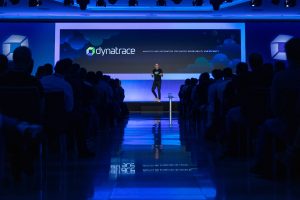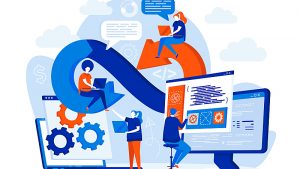In today’s digital world, software is everywhere. And it covers more than just applications, application programming interfaces, and microservices. Software is behind most of our human and business interactions. This, in turn, accelerates the need for businesses to implement the practice of software automation to improve and streamline processes.
In what follows, we define software automation as well as software analytics and outline their importance. We also discuss the role of AI for IT operations (AIOps) and more.
What is software automation?
Software automation is the practice of creating software applications to reduce or eliminate human intervention in repetitive, time-consuming IT tasks and cloud operations. Software automation enables digital supply chain stakeholders — such as digital operations, DevSecOps, ITOps, and CloudOps teams — to orchestrate resources across the software development lifecycle to bring innovative, high-quality products and services to market faster.
What is software analytics?
Software analytics offers the ability to gain and share insights from data emitted by software systems and related operational processes to develop higher-quality software faster while operating it efficiently and securely. This involves big data analytics and applying advanced AI and machine learning techniques, such as causal AI. It provides valuable insight into complex public, private, and hybrid cloud IT structures, systems, and frameworks.
Practical applications of software analytics include the following:
- measuring the health of software systems in relation to security, efficiency, complexity, transferability, and cloud readiness;
- determining the functional and technical size of software to be developed according to technical specifications;
- detecting software flaws to prevent potential outages, data corruption or theft, and security breaches;
- visualizing software structure and private, public, and hybrid cloud architecture; and
- assessing performance by implementing software benchmarks.
Additionally, software analytics enhances the digital customer experience by enabling faster service for high-quality offerings.
Software analytics enables software automation
Software analytics enables software automation with targeted machine learning and AI algorithms that mimic the way humans think to perform repetitive tasks. These algorithms analyze massive amounts of complex structured and unstructured data to enhance human decision making and performance.
Intelligent software automation combines cognitive and AI technologies, such as natural language processing, to build smart processes and workflows that learn, adapt, and improve with every IT software instance or digital transaction. The result is increased efficiency, reduced operating costs, and enhanced productivity.
Primary intelligent software automation use cases for any business include the following:
- Development. Automate DevOps pipelines to create better software faster to free up critical DevOps and IT time for new initiatives and innovation. Consider how AI-enabled chatbots such as ChatGPT and Google Bard help DevOps teams write code snippets or resolve problems in custom code without time-consuming human intervention.
- Operations. Automatically predict and resolve problems before they affect users with precise, AI-powered insights and real-time remediation.
- Business. Boost conversions and revenue with machine learning and AI-powered deep understanding to optimize user interactions.
The importance of software automation and analytics
Software automation is the backbone of digital transformation and modern IT environments. Implementing a unified software automation and analytics platform to power observability, security, and business solutions for various practices eliminates tedious, repetitive tasks, reduces human error, and frees up valuable time to focus on high-value initiatives.
Intelligent software automation can give organizations a competitive edge by analyzing historical and compute workload data in real time to automatically provision and deprovision virtual machines and Kubernetes. This way, organizations can meet employee and customer demand 24/7 while staying optimized with respect to budget and resources.
The role of AIOps in software automation and analytics
In software automation and analytics, AIOps’ role is to apply advanced machine learning and AI analytics to automate cloud operations. DevSecOps and ITOps teams can then perform tasks with accuracy at the speed a business requires.
The core benefits of an AIOps-automated software analytics platform include the following:
- Infrastructure monitoring. Instantly analyze massive volumes of observability, security, and business data for precise, AI-powered insights.
- Applications and microservices monitoring. Automatically connect distributed traces with logs for improved application availability, performance, and agility.
- Application security. Investigate network systems and application security incidents quickly for near-real-time remediation.
- Digital experience. Improve user experience with fast, reliable application performance across all digital channels. These include mobile, web, Internet of Things, and application programming interfaces.
- Business analytics. Analyze business data contextually from any source to unlock new business use cases.
- Cloud automation. Automate DevSecOps processes at scale.
AIOps also increases the quality and accuracy of the information used to evaluate the performance of IT networks, systems, and cloud-native infrastructure, resulting in faster mean time to detect and mean time to repair.
How to implement software automation
Implementing software automation will be a different process with different goals for each enterprise, depending on where the organization is on its path to digital transformation. There is no one-size-fits-all approach, but there are common goals, such as optimizing automation, self-healing, vulnerability management, and observability across the software development lifecycle.
One way to accomplish this is by implementing AIOps as part of an organization’s larger cloud adoption strategy. AIOps intelligent cloud automation provides self-service cloud observability and monitoring-as-code approaches that allow DevSecOps, ITOps, and business teams to build feedback loops into their applications automatically with just a few clicks.
Upgrade your data insights with a lakehouse for software and business data
Implementing AIOps intelligent software automation as part of any cloud adoption strategy is critical to driving innovation and achieving faster time to market for software products and digital services. Powered by big data, adding a causational data lakehouse approach to the increasing volumes of data provides greater capacity to cost-efficiently unify, store, and contextually analyze this big data in real time and near-real time.
The Dynatrace unified software automation and analytics platform, featuring the Davis AI engine, can help an organization jump-start its automation journey with precise, AI-driven insights, root-cause analysis, automated remediation, and intelligent full-stack observability.





Looking for answers?
Start a new discussion or ask for help in our Q&A forum.
Go to forum